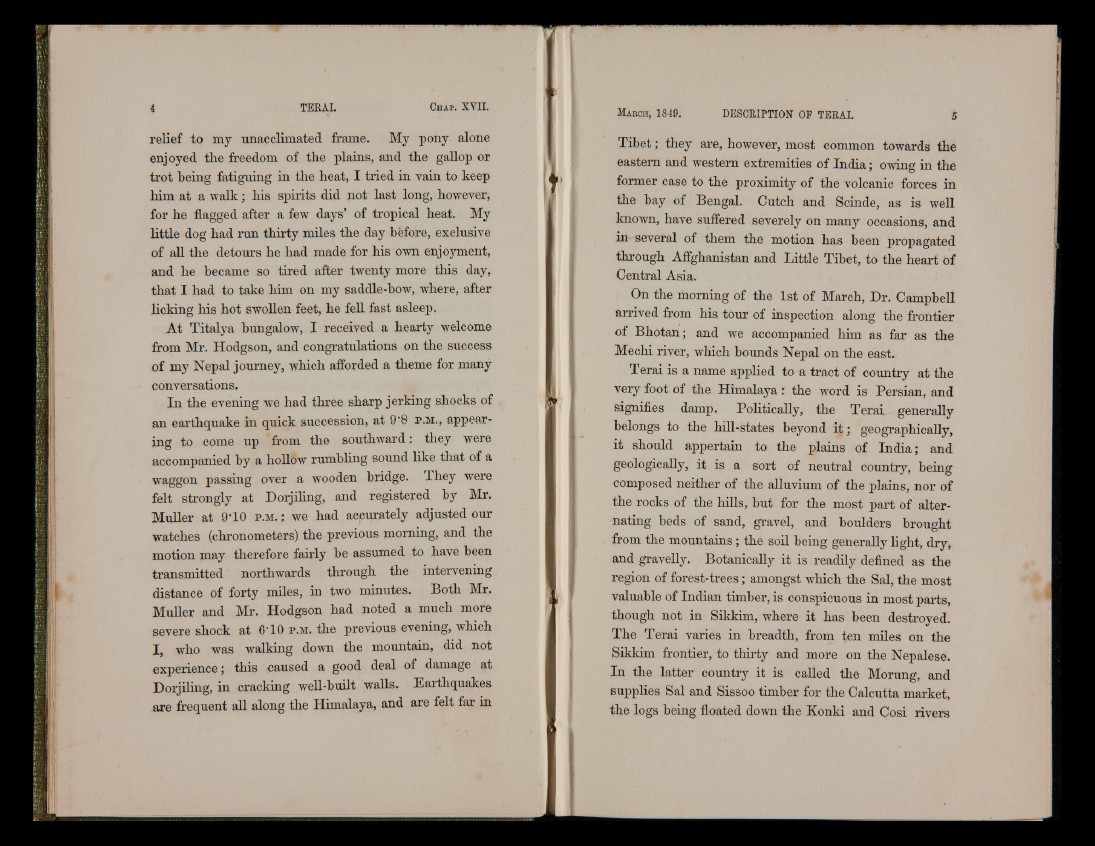
relief to my unacclimated frame. My pony alone
enjoyed the freedom of the plains, and the gallop or
trot being fatiguing in the heat, I tried in vain to keep
him at a walk; his spirits did not last long, however,
for he flagged after a few days’ of tropical heat. My
little dog had run thirty miles the day before, exclusive
of all the detours he had made for his own enjoyment,
and he became so tired after twenty more this day,
that I had to take him on my saddle-how, where, after
licking his hot swollen feet, he fell fast asleep.
At Titalya bungalow, I received a hearty welcome
from Mr. Hodgson, and congratulations on the success
of my Nepal journey, which afforded a theme for many
conversations.
In the evening we had three sharp jerking shocks of
an earthquake in quick succession, at 9*8 p .m ., appearing
to come up from the southward: they were
accompanied by a hollow rumbling sound like that of a
waggon passing over a wooden bridge. They were
felt strongly at Dorjiling, and registered by Mr.
Muller at 9 TO p .m . : we had accurately adjusted our
watches (chronometers) the previous morning, and the
motion may therefore fairly be assumed to have been
transmitted northwards through the intervening
distance of forty miles, in two minutes. Both Mr,
Muller and Mr. Hodgson had noted a much more
severe shock at 6T0 p .m . the previous evening, which
I, who was walking down the mountain, did not
experience; this caused a good deal of damage at
Dorjiling, in cracking well-built walls. Earthquakes
are frequent all along the Himalaya, and are felt far in
T ib e t; they are, however, most common towards the
eastern and western extremities of In d ia ; owing in the
former case to the proximity of the volcanic forces in
the bay of Bengal. Cutch and Scinde, as is well
known, have suffered severely on many occasions, and
in several of them the motion has been propagated
through Affghanistan and Little Tibet, to the heart of
Central Asia.
On the morning of the 1st of March, Dr. Campbell
arrived from his tour of inspection along the frontier
of Bhotan; and we accompanied him as far as the
Mechi river, which bounds Nepal on the east.
Terai is a name applied to a tract of country at the
very foot of the Himalaya : the word is Persian, and
signifies damp. Politically, the Terai generally
belongs to the hill-states beyond i t ; geographically,
it should appertain to the plains of In d ia ; and
geologically, it is a sort of neutral country, being
composed neither of the alluvium of the plains, nor of
the rocks of the hills, but for the most part of alternating
beds of sand, gravel, and boulders brought
from the mountains; the soil being generally light, dry,
and gravelly. Botanically it is readily defined as the
region of forest-trees; amongst which the Sal, the most
valuable of Indian timber, is conspicuous in most parts,
though not in Sikkim, where it has been destroyed.
The Terai varies in breadth, from ten miles on the
Sikkim frontier, to thirty and more on the Nepalese.
In the latter country it is called the Morung, and
supplies Sal and Sissoo timber for the Calcutta market,
the logs being floated down the Konki and Cosi rivers